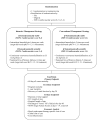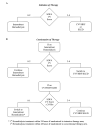Design of the VA/NIH Acute Renal Failure Trial Network (ATN) Study: intensive versus conventional renal support in acute renal failure
- PMID: 16317811
- PMCID: PMC1351394
- DOI: 10.1191/1740774505cn116oa
Design of the VA/NIH Acute Renal Failure Trial Network (ATN) Study: intensive versus conventional renal support in acute renal failure
Abstract
The optimal management of renal replacement therapy (RRT) in acute renal failure (ARF) is uncertain. The VA/NIH Acute Renal Failure Trail Network Study (ATN Study) tests the hypothesis that a strategy of intensive RRT will decrease 60-day all-cause mortality in critically ill patients with ARF. Dose separation between the two treatment arms is achieved by increasing the frequency of intermittent hemodialysis (IHD) and sustained low efficiency dialysis (SLED) treatments from three times per week to six times per week, and by increasing continuous venovenous hemodiafiltration (CVVHDF) effluent volume from 20 mL/kg/hr to 35 mL/kg/hr. In both treatment arms, subjects convert between IHD and CVVHDF or SLED as hemodynamic status changes over time. This strategy attempts to replicate the conversion between modalities of RRT that occurs in clinical practice. However, in order to implement this strategy, flexible criteria needed to be developed to provide a balance between the need for uniformity of treatment between groups and practitioner discretion regarding modality of RRT to maintain patient safety. In order to address safety and ethical issues similar to those raised by the Office of Human Research Protections in its review of the ARDS Network studies, a survey of practitioner practices was performed and observational data on the management of RRT in comparable critically ill patients with ARF managed outside of the research context is being collected prospectively. These data will help inform the study's DSMB and site IRB's of the relationship between the study's treatment arms and concurrent clinical practice.
Figures
Similar articles
-
Intensity of Renal Replacement Therapy and Duration of Mechanical Ventilation: Secondary Analysis of the Acute Renal Failure Trial Network Study.Chest. 2020 Oct;158(4):1473-1481. doi: 10.1016/j.chest.2020.05.542. Epub 2020 May 26. Chest. 2020. PMID: 32470389 Free PMC article. Clinical Trial.
-
Renal replacement therapy in the ICU: intermittent hemodialysis, sustained low-efficiency dialysis or continuous renal replacement therapy?Curr Opin Crit Care. 2018 Dec;24(6):437-442. doi: 10.1097/MCC.0000000000000541. Curr Opin Crit Care. 2018. PMID: 30247213 Review.
-
Comparison of outcomes of different modalities of renal replacement therapy in patients of acute kidney injury: a single centre prospective observational study.Rom J Intern Med. 2023 Dec 28;62(2):138-149. doi: 10.2478/rjim-2023-0033. Print 2024 Jun 1. Rom J Intern Med. 2023. PMID: 38153884
-
Continuous renal replacement therapy versus intermittent hemodialysis as first modality for renal replacement therapy in severe acute kidney injury: a secondary analysis of AKIKI and IDEAL-ICU studies.Crit Care. 2022 Apr 4;26(1):93. doi: 10.1186/s13054-022-03955-9. Crit Care. 2022. PMID: 35379300 Free PMC article. Clinical Trial.
-
Timing, dose and mode of dialysis in acute kidney injury.Curr Opin Crit Care. 2011 Dec;17(6):556-61. doi: 10.1097/MCC.0b013e32834cd360. Curr Opin Crit Care. 2011. PMID: 22027405 Review.
Cited by
-
Model to predict mortality in critically ill adults with acute kidney injury.Clin J Am Soc Nephrol. 2011 Sep;6(9):2114-20. doi: 10.2215/CJN.02900311. Clin J Am Soc Nephrol. 2011. PMID: 21896828 Free PMC article.
-
Restrictive versus Liberal Rate of Extracorporeal Volume Removal Evaluation in Acute Kidney Injury (RELIEVE-AKI): a pilot clinical trial protocol.BMJ Open. 2023 Jul 7;13(7):e075960. doi: 10.1136/bmjopen-2023-075960. BMJ Open. 2023. PMID: 37419639 Free PMC article.
-
Health-related quality of life as a predictor of mortality among survivors of AKI.Clin J Am Soc Nephrol. 2012 Jul;7(7):1063-70. doi: 10.2215/CJN.00450112. Epub 2012 May 17. Clin J Am Soc Nephrol. 2012. PMID: 22595826 Free PMC article. Clinical Trial.
-
A centralized informatics infrastructure for the National Institute on Drug Abuse Clinical Trials Network.Clin Trials. 2009 Feb;6(1):67-75. doi: 10.1177/1740774508100983. Clin Trials. 2009. PMID: 19254937 Free PMC article.
-
Lessons for successful study enrollment from the Veterans Affairs/National Institutes of Health Acute Renal Failure Trial Network Study.Clin J Am Soc Nephrol. 2008 Jul;3(4):955-61. doi: 10.2215/CJN.05621207. Epub 2008 Apr 2. Clin J Am Soc Nephrol. 2008. PMID: 18385390 Free PMC article.
References
-
- Star RA. Treatment of acute renal failure. Kidney Int. 1998;54:1817–31. - PubMed
-
- Lameire N, Vanholder R. Pathophysiologic features and prevention of human and experimental acute tubular necrosis. J Am Soc Nephrol. 2001;12(Suppl 17):S20–S32. - PubMed
-
- Karsou SA, Jaber BL, Pereira BJG. Impact of intermittent hemodialysis variables on clinical outcomes in acute renal failure. Am J Kidney Dis. 2000;35:980–991. - PubMed
-
- Mehta RL, Letteri JM. Current status of renal replacement therapy for acute renal failure. A survey of US nephrologists. Am J Nephrology. 1999;19:377–82. - PubMed
-
- Bonventre JV. Daily hemodialysis - will treatment each day improve the outcome in patients with acute renal failure. N Engl J Med. 2002;346:632–34. - PubMed
Publication types
MeSH terms
Grants and funding
LinkOut - more resources
Full Text Sources
Medical



